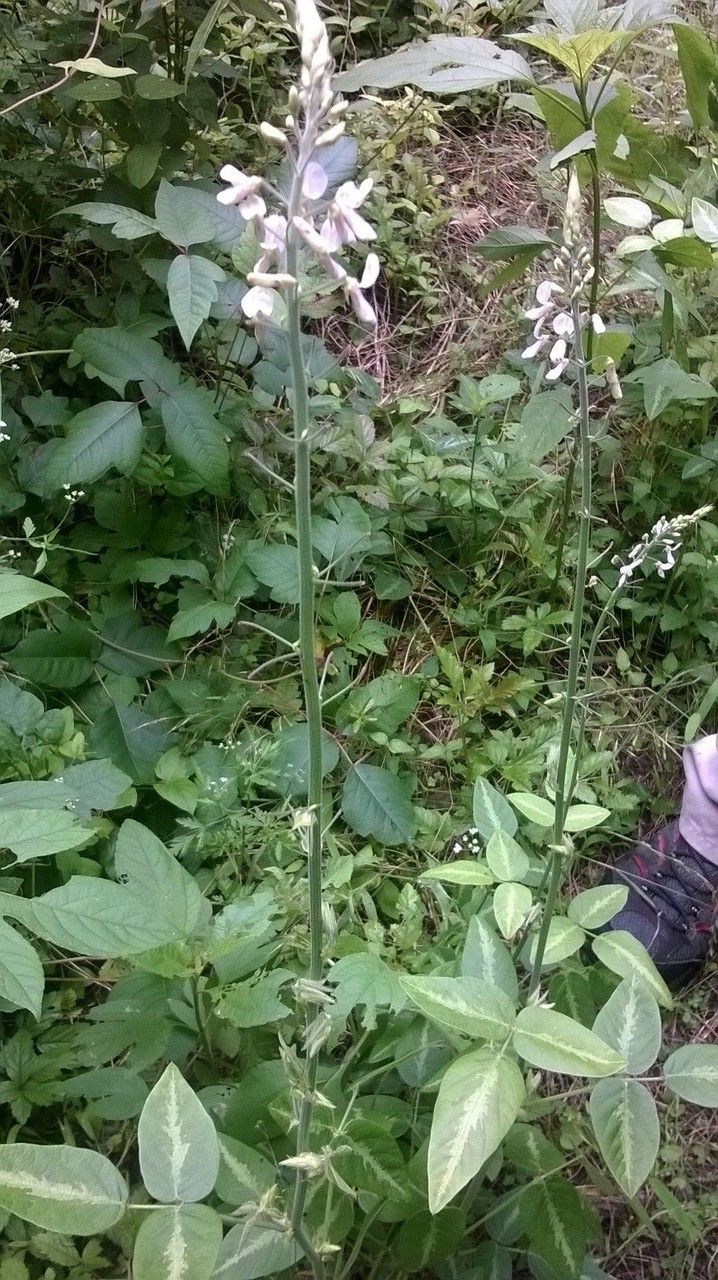Tweedy's Desmodium
desmodium tweedyi
Also known as: ["Tweedy's Tick Trefoil"]
Overview
A perennial herbaceous plant in the pea family, native to North America.
Benefits & Perks
["wildlife attractant (bees, butterflies, birds)"]
Botanical Classification
| Phylum: | Magnoliophyta |
| Class: | Magnoliopsida |
| Order: | Fabales |
| Family: | Fabaceae |
| Genus: | Desmodium |
| Botanical Name: | Desmodium tweedyi |
Plant Characteristics
Basic Information
- Category: Herbs & Weeds
- Suitable Location: raised garden bed or container in partial shade
- Suitable For:
- Is Weed: No
- Allergenicity: low
Environmental Needs
- Climate: {"temperatureRange":"10–30°C"}
- Hardiness: {"zones":"7–9"}
- Misting: every 2–3 days in dry conditions, otherwise rarely required
- Drainage: Fast-draining to prevent waterlogging.
- Soil Type: Well-draining, loamy soil with organic matter.
Maintenance Level
- Maintenance Level: moderate
- Toughness Level: moderate
- Pruning Frequency: As needed, typically every 6–12 months or after flowering.
- Pruning Intensity: Moderate; remove up to one-third of growth if overgrown.
Care Details
Ideal Sunlight Coverage:
Bright indirect light for 6–8 hours daily; tolerate partial shade, especially in hot climates.
Sunlight Tolerance Tips:
Acclimate gradually to intense light; protect from direct midday sun to prevent scorching; adjust placement based on indoor/outdoor conditions.
Care Requirements
Care Difficulty
moderatemoderate
Sunlight
partial shade to full sun
Rotate plant for even growth; use sheer curtains to filter intense light; avoid sudden light changes.
Watering
every 7–10 days during active growth, reduce in winter
Water deeply but infrequently; ensure proper drainage; avoid waterlogging.
Soil
well-draining, loamy soil with moderate organic matter
pH: Slightly acidic to neutral (pH 6.0–7.0).
Use a mix of potting soil, perlite, and compost; avoid heavy clay soils; ensure pots have drainage holes.
Temperature
Prefers 65–75°F (18–24°C); tolerates 50–85°F (10–29°C); avoid extreme fluctuations.
Monitor room temperature; avoid placing near heating/cooling vents; use a thermometer for accuracy.
Fertilizing
every 4–6 weeks during growing season, none in winter
Fertilize only when actively growing; flush soil occasionally to prevent salt buildup; avoid over-fertilizing.
Propagation
Methods
Stem cuttings in spring/summer.
Step-by-Step Propagation Guide
- Take 4–6 inch cuttings.
- Remove lower leaves.
- Dip in hormone.
- Plant in medium.
- Maintain humidity.
Best Time: Spring or early summer when growth is active.
Environment
High humidity (70–90%), warm (70–75°F), indirect light.
Medium
Well-draining mix of peat, perlite, and sand.
Hormone
Optional but recommended for faster rooting.
Timeline
Roots in 3–6 weeks; establish in 2–3 months.
Tools Needed
Pruners, rooting hormone, misting spray, plastic bag or dome.
Quick Tips
Use healthy, non-flowering stems; keep soil consistently moist; provide bottom heat for faster rooting.
Pruning & Repotting
Pruning Guide
Method
Pinch back tips or cut just above a leaf node to promote branching.
Pruning Plan
Remove dead or leggy growth to encourage bushiness; shape as needed for aesthetics.
Tools
Clean, sharp pruners or scissors.
Checklist
Sanitize tools; prune dead/damaged growth; shape plant; clean up debris.
Repotting Guide
Best Season
Spring, before active growth begins.
Pot Size
One size larger pot (1–2 inches wider in diameter).
Method
Remove plant gently; trim roots if needed; place in new pot with fresh soil; water lightly.
Suggestions
Repot every 2–3 years or when roots fill the pot; use fresh soil to refresh nutrients.
Checklist
Check root bound status; prepare new pot; trim roots; add fresh soil; water lightly.
Advanced Care Tips
Watering Mastery
Watering Checklist
Check soil moisture; water deeply; ensure drainage; adjust for season.
How to Apply Water Properly
Water at the base of the plant, ensuring moisture reaches the root zone; allow excess water to drain away; water in the morning to reduce evaporation and fungal risk.
Watering Schedule Tips
Water thoroughly when the top inch of soil feels dry; reduce frequency in winter to prevent root rot.
Soil Improvement
Add perlite or sand for drainage; incorporate compost for fertility; ensure aeration with organic matter.
Temperature Stress Management
Signs of Temperature Issues
Wilting, leaf drop, or chlorosis in cold; scorching or stunted growth in heat.
Cold Stress
Slows growth, causes leaf discoloration, and may lead to root damage in prolonged cold.
Solution: Move to a warmer location; insulate pots; avoid cold drafts; reduce watering.
Hot Stress
Leaves may scorch, wilt, or drop; growth may slow due to excessive heat.
Solution: Provide shade; increase humidity; water more frequently but avoid waterlogging; use shade cloth if needed.
Fertilizing Guide
Fertilizing Checklist
Check growth phase; dilute fertilizer; apply to moist soil; rinse between feedings.
Fertilizing Method
Use balanced liquid fertilizer diluted to half strength every 4–6 weeks during growing season (spring/summer); cease in fall/winter.
Common Problems & Solutions
Toxicity Warning
Cats
Non-toxicDesmodium tweedyi is not known to be toxic to cats. There are no reported adverse effects from ingestion or contact with this plant.
⚡ Toxic If:
None
Dogs
Non-toxicDesmodium tweedyi is not known to be toxic to dogs. There are no reported adverse effects from ingestion or contact with this plant.
⚡ Toxic If:
None
Humans
Non-toxicDesmodium tweedyi is not known to exhibit toxic properties to humans under normal circumstances. It is generally considered safe for human contact and consumption.
⚡ Toxic If:
None
Frequently Asked Questions
Q: Is Desmodium tweedyi toxic to pets?
A: There is insufficient data on its toxicity to pets.
Q: What are the common uses of Desmodium tweedyi?
A: It is primarily valued for its ecological role in supporting wildlife.
Q: How difficult is it to grow Desmodium tweedyi?
A: It requires moderate care and maintenance, making it suitable for enthusiasts rather than beginners.
Quick Reference
| Family: | Fabaceae |
| Care: | moderate |
| Light: | partial shade to full sun |
| Water: | every 7–10 days during activ |
Get Expert Care Tips
Download the Plantious app for personalized care reminders and plant identification!
Google Play App Store





